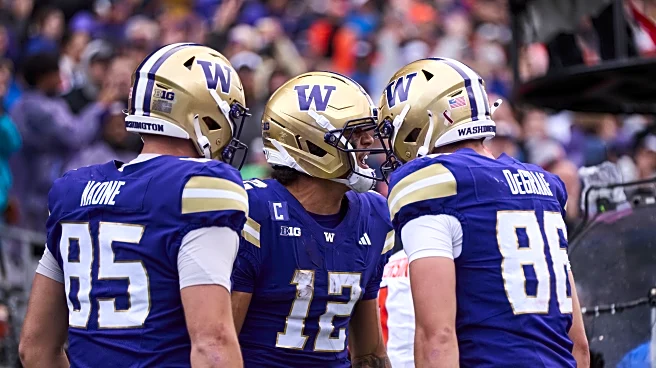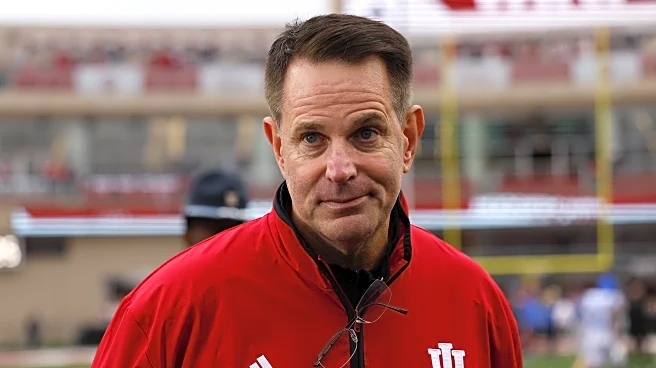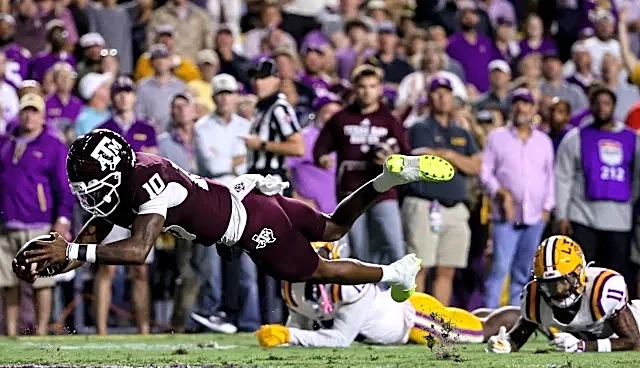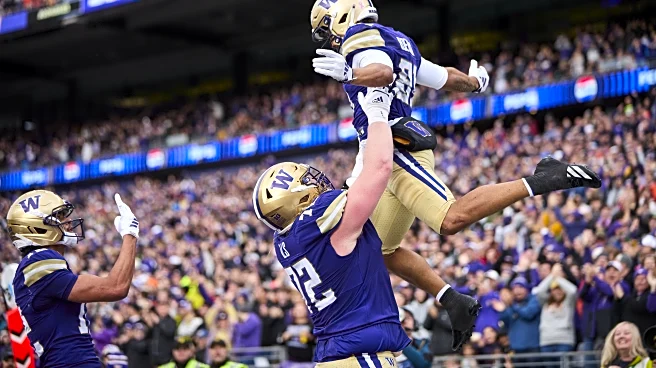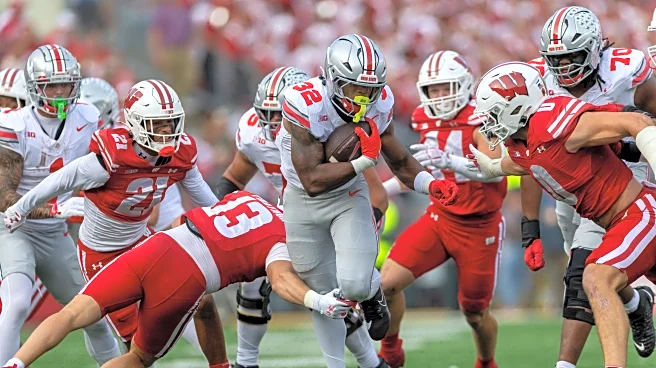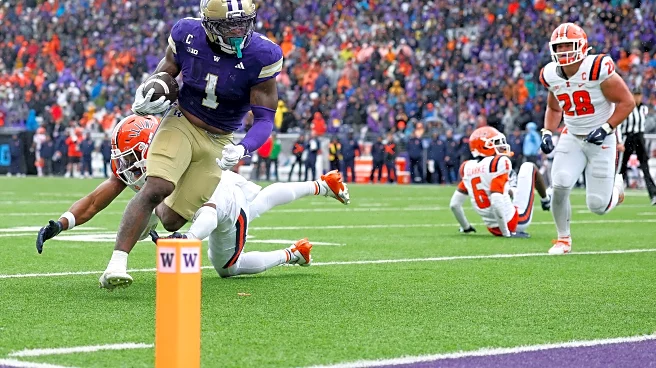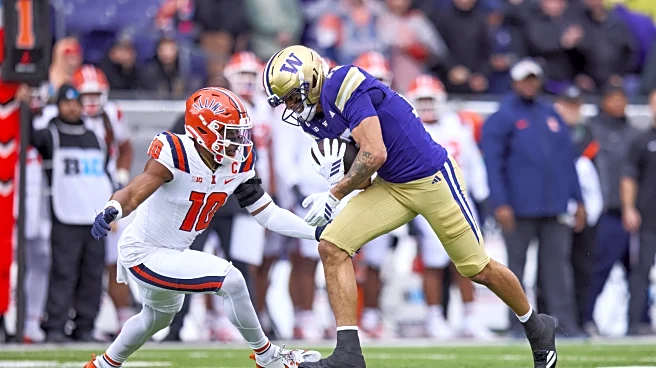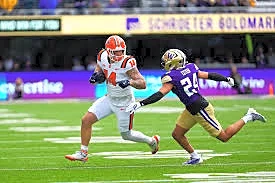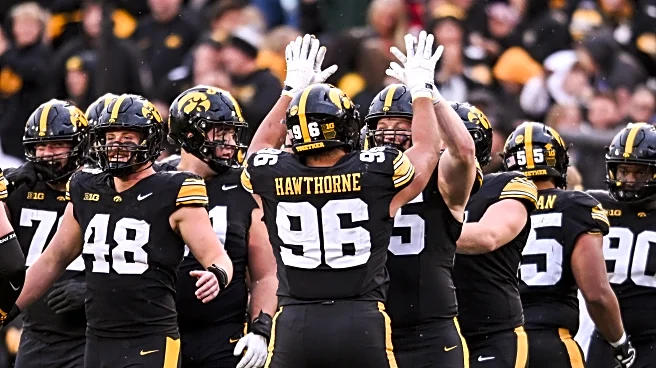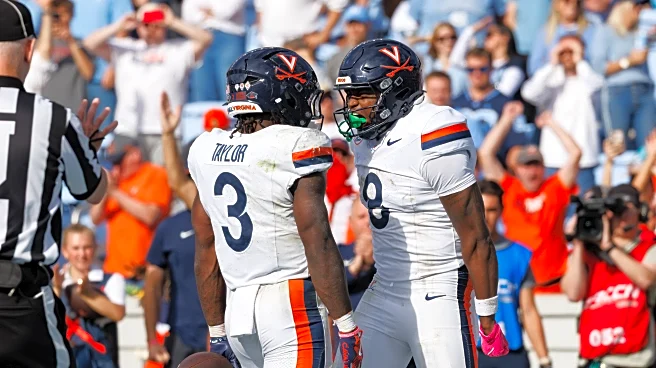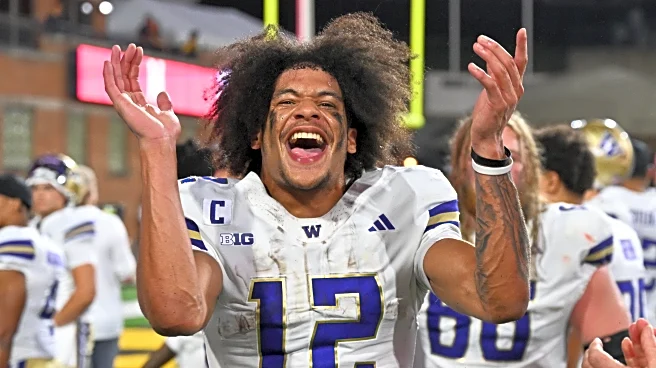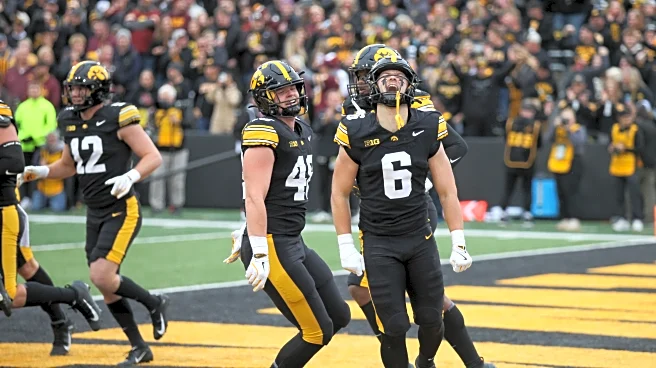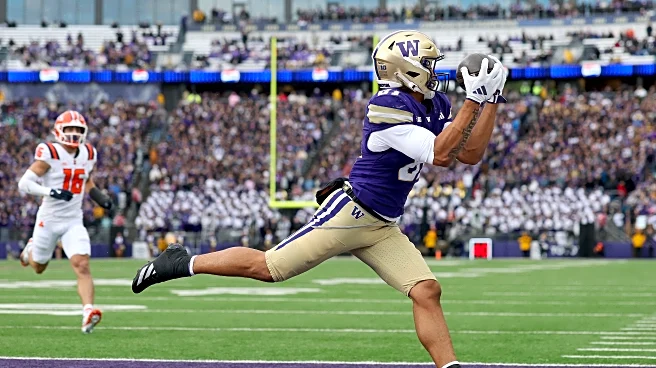
The Washington Huskies return to the win column in style, as they take down their first ranked opponent on the year in the (formerly) #23 ranked Illinois Fighting Illini. It was the Demond x Denzel show as they led the offense in what is hopefully the start of a new lengthy home win streak at Husky Stadium. Getting back two starting offensive linemen from injury in Willis and Mills showed how important and crucial that games can come down to the trenches. The Dawgs officially match their win total
from last season and clinched another bowl berth. However the team has their eyes set on even more, as a CFP berth is still within the realm of possibility.
To the film.
Offense: Making Demond’s Life Easier

Look what a difference a complete offensive line makes. UW fans already know this all too well after last year’s challenges up front, but the difference was stark this past weekend. The return of Carver Willis and John Mills on the left side of the line was a huge boost to the offense in more ways than one. Not only are they great in protection, giving Demond time to get through his reads, but their presence also set up other opportunities outside of the structure of the offense.
Their return to the starting line up was the most noticeable cause for our offense’s resurgent performance, but there were other, more subtle changes in play calling and schematic emphasis that seemed to make a difference. Fisch put a lot of emphasis on simplifying reads and beefing up protection schemes to keep Demond in rhythm.
Let’s take a look at the film to explain what I’m seeing.
1st Quarter – 9:41 – 3rd & Goal

First up here we have a play that I picked to highlight the ancillary benefits to getting Willis and Mills back up front. When we think about grading the offensive line, most think of their ability to open rushing lanes for the running backs and keeping the QB clean in the pocket. Specifically for pass protection, the initial thought is a good OL minimizes sacks and pressures. All of those things are definitely important, but with a dual-threat QB like Demond, the equation changes a little bit.
Ohio State, Maryland, and Michigan all employed defensive game plans that focused on keeping Demond in the pocket to corral ability to hurt them on the ground. Not only that, but with disciplined pass rush contain and QB spies, Demond wasn’t able to get scramble drill looks downfield when guys weren’t getting open within the structure of the play call. This second chance look late in the down is often when Demond’s magic comes through and we can’t out talent our opponent.
Where Willis and Mills factor in to this is their style of pass protection. There’s an old OL coaching adage that says “pass protection isn’t passive.” Willis and Mills embody that the best among our OL. They don’t just try to stop the pass rush. They try to bury them. On this play were in 3rd & long inside the red zone, and Illinois is trying to force a field goal by rushing four and dropping eight into a soft Cover 4 look. We’re trying to get a catch-and-run on this play call to set up a possible 4th down conversion attempt, but the coverage is playing too deep to give Demond a shot at the end zone or a worthwhile catch-and-run shot. However, by only rushing four, Mills is left without a rusher to pick up at the snap, so he shifts into search-and-destroy mode. Seeing that the DTs are slow playing their rush, Mills flips his attention outside to Willis’ defender and smokes him.
Mills’ extra block on the DE leaves a massive scramble lane for Demond to break contain through. Demond finds Roebuck on the scramble drill, and Roebuck fights his way into the endzone for our first TD of the game. Bringing that road grader mentality to pass protection is a great way to neutralize a pass rush that’s focusing on contain.
1st Quarter – 3:25 – 2nd & 10

While it’s great to have Willis and Mills back, our improvements in pass protection weren’t solely due to their return. It was obvious that Fisch made an extra effort to scheme up extra time for our plays to develop. Here on this play we’ve got Jumbo 12 personnel (1 TE & a 6th OL) with Decker DeGraaf (TE, #86) starting out on the right side of the formation and our extra OL (Zach Henning, #80) lined up on the right side of the formation. We’ve run this personnel grouping a bit after Quentin Moore, our usual blocking TE, got hurt against Michigan, so it shouldn’t have surprised Illinois that much. Henning is pretty clearly not a dangerous receiving threat, but he does present a legitimate threat as a blocking mismatch in the run game. Leaning on this, we’re running a heavy protection, hard play action passing concept to take advantage of the anticipated run that the defense is prepping for.
At the snap, we pull DeGraaf and Geirean Hatchett (RG, #56) to the left side of the formation, feigning GH Counter blocking. This not only sells the defense on the run action, sucking the LBs up towards the line, but it also creates a 7-man protection look that includes 6 OL and a TE. At the time of his release, a full three seconds into the play, Demond doesn’t have a defender within 5 yards of him, plus with the blocking scheme feigning run action, Illinois’ defensive front squeezed down instead of fanning out to play contain. If Denzel Boston or one of our other WRs didn’t get open downfield, Demond would’ve had plenty of space to run a scramble drill.
Excellent use of personnel grouping tendencies and alternate play action blocking schemes to buy time and create options for Demond.
1st Quarter – 0:53 – 1st & 10

Next up we have a play that resulted in Dezmen Roebuck’s second TD of the game late in the first quarter. What we wanted to focus on here is the play concept and Fisch’s continued emphasis on simplifying Demond’s reads through his play design.
On this play we’re running a “Nub” formation that we’ve talked about extensively on Film Study. As a refresher, a Nub formation is a 3×1 formation with 11 personnel. It aligns our three WRs in a Trips alignment to one side and our TE on the solo side in a Y-TE alignment attached to the formation. Fisch likes this formation to set up pass plays for two reasons. One, by keeping the TE attached to the formation, we are able to use the TE and the RB in 7-man protection, which was another point of emphasis in this game that we highlighted in the last play. Two, by having the three WRs to the opposite side of the formation from the TE, we can sometimes force the defense to tip their zone or man coverage call based on who they have assigned to cover the WRs. With Illinois keeping just their CB, nickel DB, and safety over our three WRs, instead of both CBs and the nickel, the offense can deduce pre-snap that it is some sort of zone coverage.

Out of this formation, Fisch has a 3-route passing concept known as “Snag” or “Spot” paired with 7-man pass protection. Snag, as I know it as, is a half-field progression with all three routes originating from the same side of the formation. It’s an evolution of the high-low Smash concept that some may be familiar with (Corner + Flat route), but even if you’re not familiar with Smash, it is a pretty straight forward concept that has answers for most coverages. As the diagram notes above, the QB progression goes from Corner (#1) to Hook Curl (#2) to Flat/Arrow (#3), and a lot of this can be pre-diagnosed before the snap if set up by the formation.
Pre-snap, Demond can see that Illinois is in a 2-high coverage shell, indicating either Cover 2 or Cover 4 assuming that they are in zone coverage based on their matchup alignments against the Nub formation that I noted above. Since Demond’s first read on this concept is the Corner route from Roebuck, what he’s looking for confirmation of post-snap is that the outside CB isn’t going to drop deep in a Cover 4 to take away the Corner route. If the CB stays shallow and it’s Cover 2, Roebuck should be running into open grass on the Corner with the safety playing inside leverage in no position to break up the pass. If the CB does drop deep into Cover 4 coverage, taking away the Corner, then Demond is reading the slot defender to see if he slides in to take away the Hook Curl or if he slides out to take away the Flat/Arrow.
It sounds like a lot to process quickly, but it’s actually a very QB-friendly progression with clear if-then rules that can mostly be worked out pre-snap. Not only that, but if Demond makes his pre-snap reads on the safety and the DB alignments to figure out that it’s probably a Cover 2/Cover4 zone look, then all he has to focus on post-snap is the CB and slot DB to one side of the field with little traffic to create confusion.
The outside CB stays shallow on this play in a Cover 2 pattern match zone coverage, so Demond knows that the ball should go to Roebuck before he even gets to the top of his drop back. He rifles the pass towards the sideline where only Roebuck can make a play on the ball, and it turns into our second TD on the day. Great play call to set Demond up for success against a favorable defensive look.
2nd Quarter – 0:52 – 3rd & 2

We wanted to throw this play into this week’s Film Study to highlight Fisch’s continued efforts to add more creativity to his red zone play calls. In our two losses, as well as in a few of our tighter games, Fisch had received some fan criticism for his perceived inability to manufacture scoring opportunities inside the red zone. While I don’t necessarily agree with all of his play calls (short side speed options for one), I don’t think that a lack of creativity is the reason why. This play is a great example of some of the trickery that Fisch has thrown at our opponents.
On this play we have another under center empty formation that Fisch’s used at times to set up trick plays (including the Demond-Denzel-Coleman double pass TD on the very next play). On many of those plays, we use Jet motion or the threat of Jet motion to influence the defensive alignment even though we seldom make the handoff. This play here is our attempt at breaking the tendency and keep the defense honest while not just throwing away the play.
To set this play up we are adding another seldom used schematic wrinkle to help the End Around outflank the defense; an unbalanced, “guard-over” formation. On this play we have Paki Finau in as the “left guard” but instead of lining up between Willis and Landen Hatchett, he sets up to Landen’s right, between Landen and Geirean. This leaves us with just Willis to the left side of the center and Finau, Geirean, Azzopardi, and the TE DeGraaf to the right of the center. Illinois doesn’t really know how to adjust their pressure look to the unbalanced look, so they actually end up overloading the left side of the line and leave us with a numerical advantage on the right (play side). Decker and Azzopardi do a good job sealing the edge for Jordan Washington on the End Around, but the EDGE also does a good job widening to string along Washington. This ends up buying just enough time for the safety and play side CB to rally in support to hold Washington to a short gain, but not quickly enough to prevent the first down.
Cool wrinkle to get the first down while also breaking a tendency and setting up future trick plays.
4th Quarter – 8:21 – 2nd & 1

Last offensive play for the week we have a nice TD play towards the end of the game to further build off of our run-heavy Jumbo personnel looks now that Henning’s taken a larger role as our Jumbo blocking TE. On this play we are using a tried and true RPO concept that Fisch has been selective with dialing up but has done a good job dressing up to suit the offense’s needs. I’ve talked about this Read Option Flat/Arrow RPO concept several times in past Film Study posts, but it’s essentially the “modern triple option” that’s dressed up to extend the pitch. It’s a basic Read Option concept that has some sort of underneath route into the flat zone that the QB can throw to as the third “pitch” option. Historically, Fisch has used DeGraaf as the pitch man, as he does on this play, but his starting alignment within the formation has moved around to keep defenses guessing.
On this play, we’re in Jumbo 13 personnel (DeGraaf, Henning, and Baron Naone at TE) with all three “TEs” lined up in a bunch alignment to the boundary. We also have Denzel lined up out wide on the line, thereby making Henning an ineligible player. This isn’t all that important in the context of the play design, but if Illinois’ defenders are paying attention to it, then it’d further emphasize a run call. The other nuance to the play design that I found interesting was DeGraaf’s starting alignment. At the snap, DeGraaf is lined up as the inside-most TE in the bunch alignment. With Henning up on the line and Naone outside of him, DeGraaf is not only shielded from a jam at the line, but he is also able to sneak past the EDGE who might get lost in his coverage assignment. While DeGraaf wasn’t able to sneak into the flat unnoticed, his alignment did confuse the EDGE just long enough to get outside of him to sneak into the end zone for a TD.
Again emphasizing my point that Fisch did a good job as a play caller supporting Demond and calling plays that emphasized Demond’s talent without asking too much of him. RPOs like this that stress the defense with his legs while giving him easy, clear-cut reads to distribute the ball off of are yet another great set of concepts.
Defense: Change Ups & Trickery

On the defensive side of the ball, the most noticeable trend in the Illinois game was our shift in coverage change up strategy. While we are still defense that predominantly plays Cover 1, Cover 3, and Tampa 2, Walters mixed and matched his presentation of these coverages while emphasizing different personnel alignments and coverage responsibilities. We saw DBs playing out of their designated position not only to confuse Illinois’ offense, but also to capitalize on our own players’ skill sets. There were CBs and Nickels at safety, and even McLaughlin at MIKE. Let’s take a look at how Walters pieced these looks together.
1st Quarter – 7:14 – 2nd & 10

First up we have a cool inverted coverage look that Walters busted out early in the game to back up a 6-man blitz. It’s a bit tricky to make sense of everything that’s going on pre-snap, so I’ve taken some snippets to let you digest the play a bit easier.

In the diagram above, you can see the final pre-snap alignment from both teams. Illinois’ offense is lined up in a basic 2×2 condensed formation with the receivers on both sides of the formation lined up tight to the formation in narrow splits. Against this, we’re showing an unconventional look on defense. We have a standard 4-man front for the DL, but instead of having our LBs line up behind the DTs, we have the LBs lined up as overhang defenders just outside of the EDGEs. Not only that, but we’re also showing a 3-high shell with Makell Esteen (safety, #24), Alex McLaughlin (safety, #12), and Rashawn Clark (slot DB, #2) all playing back deep. You sometimes see 3-3-5 teams use this type of 3-high look when they play 3 true safeties, but rarely do you see it outside of that. The closes equivalent look you might see with some regularity is Tampa 2 where the MIKE drops back as a quasi-safety to present a similar 3-deep look that doesn’t include the CBs playing deep. As I mentioned earlier, we do play a decent amount of Tampa 2, so I think that this look was an attempt at baiting Illinois into thinking that we’re in a Tampa 2.

Post-snap, we actually run an “inverted” Cover 3 coverage look. I tried to mark up the snippet to illustrate this better. Instead of our three deep DBs fanning out to cover the three deep zones, like they would in a 3-3-5 defense or in a Tampa 2 look, we instead play a more conventional Cover 3 look out of the unique pre-snap alignment. Esteen and Clark both rotate down to cover the underneath zones while our CBs and McLaughlin drop back in Cover 3. Illinois ends up not being fooled and they hit an underneath route against our undermanned underneath coverage for a decent gain, but it’s the appearance of complexity that we’re trying to use to our advantage here.
2nd Quarter – 4:08 – 1st & 10

Next up we have another defensive play where we’re running one of our standard coverages, but this time we’re shaking up our coverage roles and playing DBs out of their usual positions to present different looks to the defense. On this play, Illinois is running a 12 personnel 4×0 formation, and we are running man Cover 1 against it. Typically in situations like this where the offense has their top two WRs to one side, we like to bump both of our CBs over to the WR side of the formation. However, instead of having 2 CBs and a safety over 2 WRs and a TE on the trips side (a more conventional man coverage set of match ups), we have 1 CB, our nickel/slot DB, and 1 safety. It’s also worth noting that the TE attached to the formation is actually ineligible since the WR2 is on the line outside of him. Anyways, we get into this coverage look by rotating Esteen over their trips side TE, drop McLaughlin over their Nub TE on the opposite side, and we move the much rangier Prysock into a free safety alignment. This not only allows us to get decent match ups on the Illinois WRs and TEs, but it also allows us to keep McLaughlin closer to the box where he works best and muddies the Illinois read between man and zone based on the trips side coverage match ups.
Illinois ends up guessing that its still man coverage and they take a shot downfield to a Slot Fade in 1v1 coverage, but Clark does a great job breaking it up. Plays like this are only made possible by having versatile DBs like Prysock, as well as having three solid man coverage options (Davis, Prysock, and Clark). Like the last play, this was another unique look that we threw at Illinois, and while we didn’t catch them misreading the coverage, we were still able to make the play.
3rd Quarter – 2:44 – 3rd & 20

Finally, we have another unique look that plays off of our earlier 3-deep look that we broke down two plays ago. However, this time, we were able to catch Illinois misreading the coverage to get a nice interception.

Like the earlier play, there’s a lot to digest prior to the snap, so I’ve taken another snippet above of our alignment just before the snap. Similar to the earlier play, we’ve got a standard 4-man front with two LBs behind them, and three DBs (Clark, McLaughlin, and Esteen) playing deep. McLaughlin isn’t playing quite as deep as the other two, but he’s bailing at the snap into deep coverage and is playing quite deep already, so we can just call him the third deep DB.

The biggest difference between the earlier play that used this 3-deep inverted Cover 3 look is that we aren’t blitzing out of it. As you can see in the clip at the top or the marked up snippet above, we have our full complement of 7 coverage defenders on this play to tighten up the coverage. We again have the two deepest DBs (Clark and Esteen) dropping down at the snap to protect the seams along the hashmarks, McLaughlin is dropping all the way into deep center field to defend against Post routes, and Davis and Prysock are bailing back into deep third coverage. The difference on this play is that we also have our LBs, Zadrius Rainey-Sale (#23) and Xe’ree Alexander (#10), also dropping into coverage in the soft flats. ZRS dropping into the flats is actually the key to this play. He knew based on the down and distance that giving up an underneath throw was OK but a throw to the intermediate or deep zones was not going to work. Knowing that, he adjusted his drop to undercut any outbreaking routes since he had inside support from Clark on the hash. ZRS lays a nice hit as the WR was getting the ball and Davis is Johnny on the spot to snag the dislodged pass for the interception.
Again, this play and the coverage assignments are almost identical to our typical Cover 3 calls, but we’re setting up in a pre-snap look that looks a whole lot like Tampa 2. If it was Tampa 2, Illinois’ Corner route probably would’ve been open for a first down, but our disguised coverage baited them into the ill-advised throw. Great call and great disguise from Walters.
Awgs’ Bonus Play(s) of the Week
Denzel Boston gets this week’s honors with this trick play leading to a passing TD for him.

As well as Demond Williams laying the boom as if he’s Marshawn Lynch with this truck for a 1st down.

